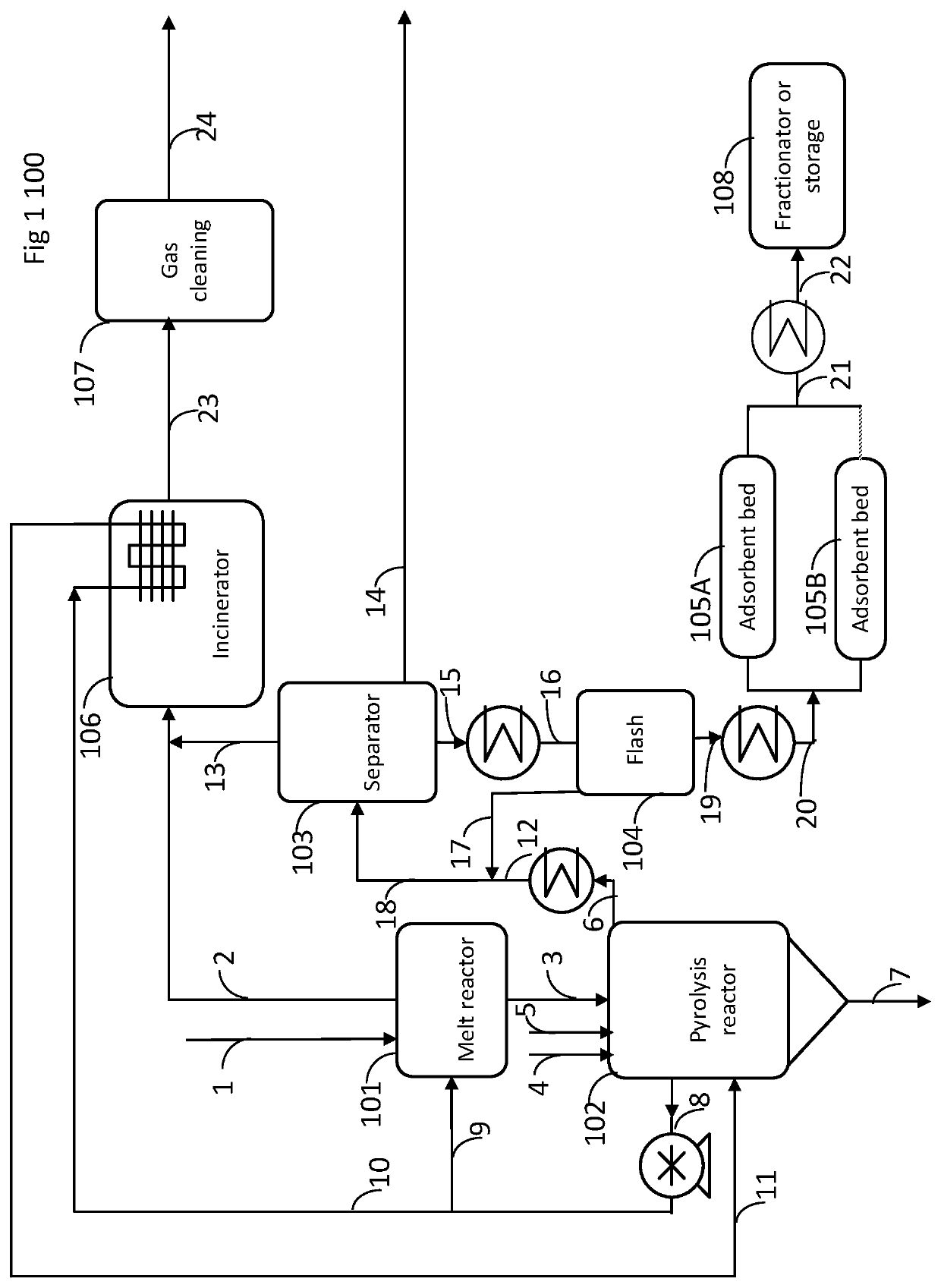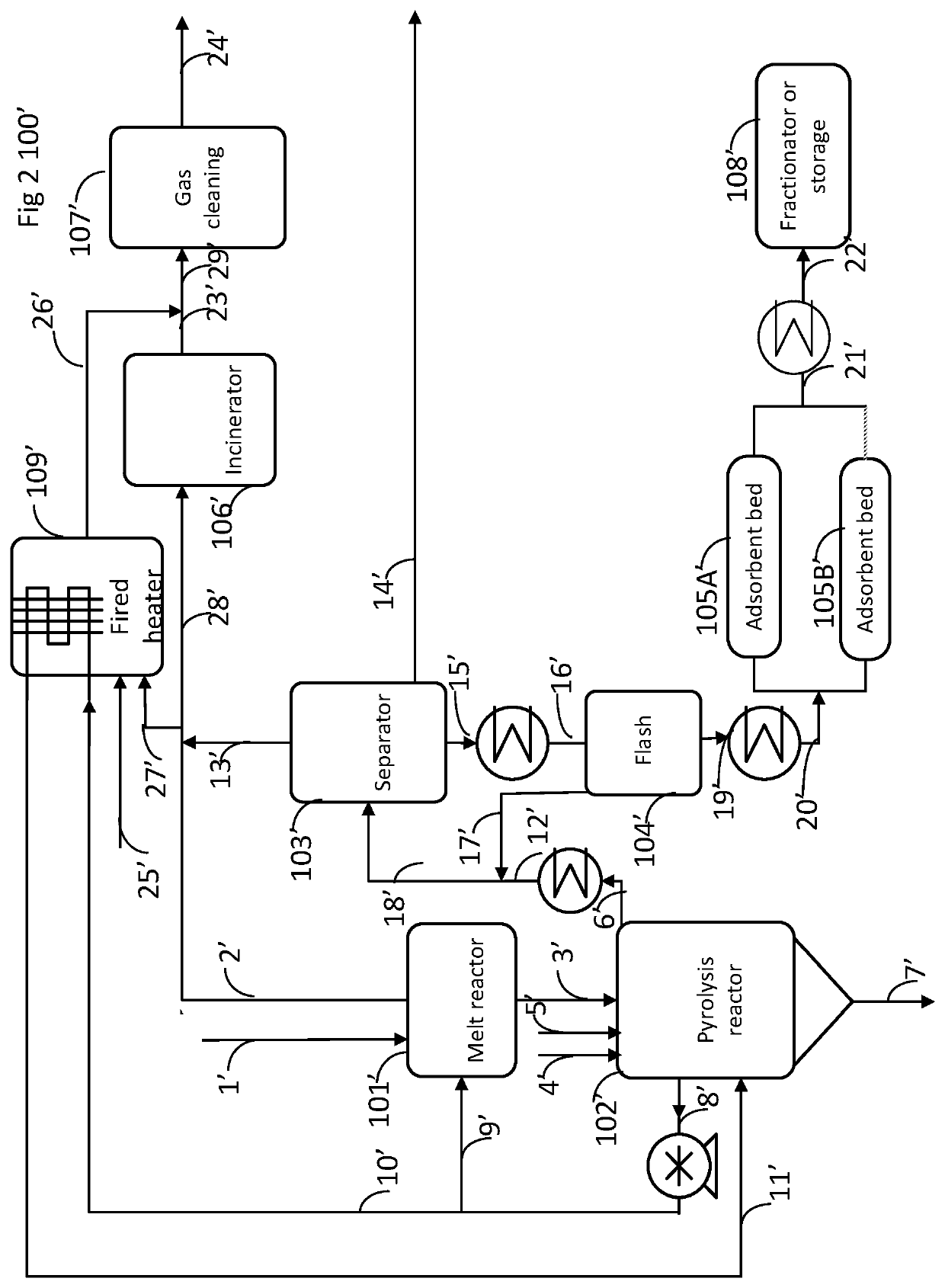Process for pvc-containing mixed plastic waste pyrolysis
a technology of mixed plastic waste and pyrolysis oil, which is applied in the direction of combustion types, lighting and heating apparatus, incinerator apparatus, etc. it can solve the problems of high cost, high cl level of products, and inability to meet the requirements of pyrolysis, so as to reduce the amount of adsorbent, enhance the fixation of chlorine, and reduce the level of products
- Summary
- Abstract
- Description
- Claims
- Application Information
AI Technical Summary
Benefits of technology
Problems solved by technology
Method used
Image
Examples
example
Example 1
[0051]Chloride mass balance studies are presented. The calculation is based on experimental data collected for melt tank dechlorination, sorbent performance and adsorbent performance. An experiment done at 320° C., feed PVC 1%, 2% or 3%, product Cl<10 ppmw. Three steps are taken in series, showing melt tank size, sorbent use and adsorbent use. The example is scaled to 1 ton / year feed flow basis. The data shows that if only one single step of chloride removal is used, a very large reactor, or large sorbent use and adsorbent use are needed (see ratios of melt tank size to reactor size to the one in three steps in series). This Example explains how using three steps in series provides synergy as compared with any or two of the three steps.
I. Information inputsCa(OH)2 Molecular weight, g / moles747474CL Molecular weight, g / moles353535Feed flow t / hr, scaled111Study cases123Feed PVC, wt %136Feed PVC, kg / hr103060Cl in feed, ppmw56721701634032RX size, main reactor size is scaled as 1...
example 2
[0052]A recycle plastic stream was obtained from a Wisconsin material recovery facility. The compositions are 2% wt PVC, 20% PE, 75% PP, the remaining being PET, paper, organic residue, and metal species. Cl measured in feed is 1.189wt % Cl.[0053]Step 1: A 100 grams of the feed was batch pyrolysised in a 500 cc reactor under conditions of atmospheric pressure ˜25 psig. The reactor was heated from ambient condition to 300C. hold for 2 hours. After shutdown, the reactor content was solidified, recovered and measured (namely, first stage liquid product).[0054]Step 2. The same feed was tested identical testing conditions as step 1. After holding at 300C for 2 hours. The reactor continued to raise to 400° C., held for one hour. After cooled, the product produced out of the pyrolysis reaction was collected in an ice-cooled condenser. 67 grams of products were collected (namely, total pyrolysis product). A few runs were repeated as step 2 to accumulate ˜300 gm of liquid product (namely, co...
specific embodiments
[0056]While the following is described in conjunction with specific embodiments, it will be understood that this description is intended to illustrate and not limit the scope of the preceding description and the appended claims.
[0057]A first embodiment of the invention is a process for producing low-chloride pyrolysis oil out of a mixed plastic waste stream comprising three chloride removal steps operating in series; melting the mixed plastic waste stream with a hot product stream in a melting reactor to produce a melted mixed plastic waste stream comprising at least two types of plastic including chlorine-containing plastics and other plastics to produce a first chloride-rich vapor stream and a first liquid stream; sending the first liquid stream to a pyrolysis reactor to be heated with a hot product stream to produce a second chloride rich vapor stream, a second liquid stream and solid particles; adding a sorbent to the pyrolysis reactor to adsorb chloride containing molecules; se...
PUM
| Property | Measurement | Unit |
|---|---|---|
| temperature | aaaaa | aaaaa |
| temperature | aaaaa | aaaaa |
| temperature | aaaaa | aaaaa |
Abstract
Description
Claims
Application Information
 Login to View More
Login to View More - R&D
- Intellectual Property
- Life Sciences
- Materials
- Tech Scout
- Unparalleled Data Quality
- Higher Quality Content
- 60% Fewer Hallucinations
Browse by: Latest US Patents, China's latest patents, Technical Efficacy Thesaurus, Application Domain, Technology Topic, Popular Technical Reports.
© 2025 PatSnap. All rights reserved.Legal|Privacy policy|Modern Slavery Act Transparency Statement|Sitemap|About US| Contact US: help@patsnap.com


